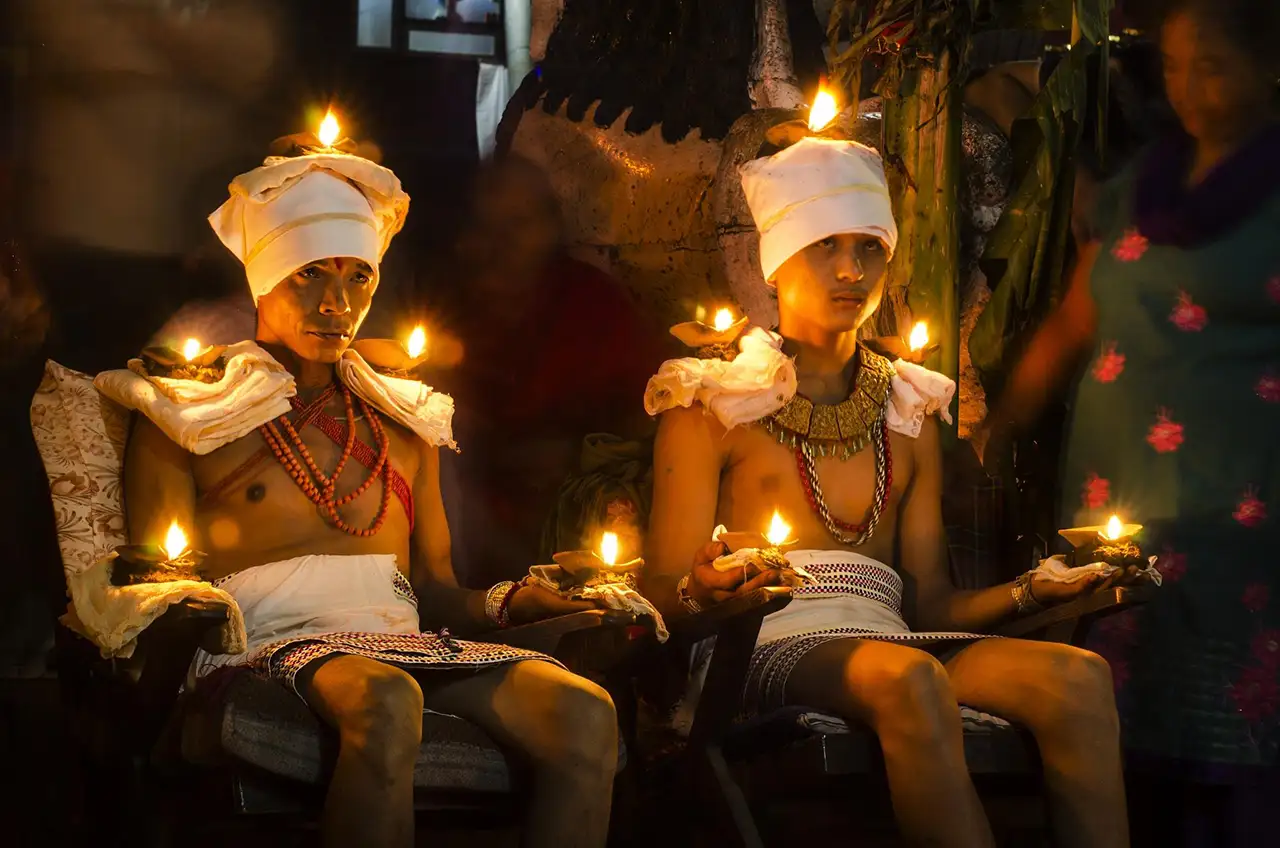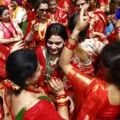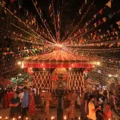Dashin, also called Dashain, is Nepal’s longest and most celebrated festival. It’s a time of vibrant colors, joyous gatherings, and deep spiritual significance. This auspicious occasion commemorates the triumph of good over evil, as exemplified by the victory of the goddess Durga over the demon Mahishasura.
During this auspicious period, Nepal transforms into a kaleidoscope of colors, sounds, and traditions. Families reunite, adorn homes with marigold garlands, and fill the air with the joyous beats of traditional music. Dashain is a time for spiritual renewal, cultural immersion, and the creation of cherished memories.
Dashin: The Longest and Most Celebrated Festival in Nepal
- Duration: The longest festival in the Nepali calendar is Dashain, which spans fifteen days. At every new dawn, unique beliefs are practiced, depicted by traditional customs and rituals handed down from elders to their younger generations.
- Celebration of Victory: At its core, Dashain celebrates the victory of good over evil. The epic battle between the goddess Durga and the demon Mahishasura symbolizes the eternal struggle between righteousness and darkness. This triumph is a powerful reminder of the importance of upholding virtuous values.
- National Significance: Dashin transcends religious and cultural boundaries, uniting Nepal’s diverse population in a shared celebration. It is when people from all walks of life come together to express their gratitude, seek blessings, and revel in the community spirit.
- Cultural Extravaganza: The festival showcases Nepal’s rich cultural heritage. Traditional music, dance, and art forms emerge during Dashain, creating a vibrant tapestry of sights and sounds. From the majestic processions to the lively street performances, the festival offers a feast for the senses.
- Spiritual Renewal: For the year of our Lord two thousand twenty-three, not only is Dashain a period for chest-beating and drum-beating, but it also denotes an era of serious religion. As a result, devotees worship Goddess Durga with prayers and sacrifices, asking her to grant them good health, wealth, and joy. This festival promotes self-examination, personal advancement, and re-dedication to spiritual uplifting.

Historical and Cultural Background of Dashain
Dashain Festival, a vibrant and cherished tradition in Nepal, is deeply connected to ancient myths and cultural practices. Ancient Hindu scriptures trace their origins, intertwining tales of divine battles and epic triumphs.
The Divine Battle: Durga and Mahishasura
Dashain’s center is the great battle between the goddess Durga and the demon Mahishasura. In Hindu belief, Mahishasura was a mighty demon who spread disorder among all beings, making it hard for good and evil to live together.
Although he was invincible, the gods combined their energies to form Durga, a warrior goddess renowned for her fierceness and inexorability. After engaging in an arduous fight for nine nights with him, she emerged victorious over Mahishasura and reinstated peace within the universe. This religious holiday marks this divine conquest, reminding us of what happens when good triumphs over evil.
The Epic Ramayana Connection
Dashain also finds resonance in the epic Ramayana. The festival celebrates Lord Rama’s victory over the demon king Ravana, who had abducted Rama’s wife, Sita. Rama’s triumph signifies the restoration of dharma (righteousness) and the defeat of adharma (unrighteousness). This narrative further reinforces Dashain’s central theme of good overcoming evil.
Cultural Significance of Dashin
Beyond its mythological roots, Dashain holds immense cultural significance in Nepal. It’s a time for families to reunite, strengthen bonds, and celebrate their shared heritage. The festival’s rituals and traditions reflect the deep-rooted values and beliefs of Nepali society.
- Family Reunions: Dashain serves as a homecoming for many Nepalis. People travel from far and wide to gather in their ancestral homes, creating an atmosphere of warmth and togetherness.
- Renewal and Gratitude: The festival signifies a time of renewal and gratitude. People express their appreciation for the blessings in their lives and seek divine blessings for the future.
- Cultural Extravaganza: Dashain showcases Nepal’s rich cultural heritage. Traditional music, dance, food, and attire take center stage during the festivities, creating a vibrant and immersive experience.
- Community Spirit: The festival fosters a strong sense of community. People participate in collective rituals, share meals, and exchange greetings, reinforcing the bonds that tie them together.
Significance of Dashain in Nepali Society
Dashin Festival, the most treasured celebration with deep spiritual and cultural values, represents all those who cannot imagine life without it. It stands out from other Nepali festivals, being the calendar’s longest and most awaited event. The festival transcends mere celebration, creating unity among families and revitalizing society. The joyous festival testifies to the triumph of right over wrong, deeply involved in society’s culture and faith.
Spiritual Significance of Dashain
- Triumph of Good over Evil: Dashain commemorates Goddess Durga’s victory over the demon Mahishasura. This divine triumph symbolizes the ultimate victory of righteousness over malevolence, inspiring individuals to uphold virtuous values.
- Blessings and Renewal: The festival is a time for spiritual renewal and seeking blessings. Devotees offer prayers to Durga, seeking her divine protection and blessings for health, prosperity, and happiness. It encourages introspection and self-improvement.
- Sacred Rituals: Various holy rituals and ceremonies mark Dashain. The sowing of barley seeds during Ghatasthapana, the offering of sacrifices on Maha Ashtami, and the receiving of Tika on Vijaya Dashami are just a few examples of the profoundly spiritual practices associated with the festival.
Cultural Importance of Dashin
- Family Bonding: Dashin strengthens family ties. It’s a time when families come together, often traveling long distances to reunite in their ancestral homes. They share meals, stories, and laughter, creating lasting memories.
- Social Harmony: The festival transcends social, ethnic, and religious boundaries, fostering a sense of unity and harmony. People from all walks of life come together to celebrate, reinforcing the bonds that tie them together as a community.
- Cultural Preservation: Dashain is vital in preserving Nepal’s rich cultural heritage. Traditional music, dance, food, and attire are integral to the festivities, ensuring the continuity of age-old customs and practices.
- Societal Renewal: The festival signifies a fresh start and a time for societal renewal. It’s an opportunity to let go of negativity, forgive past grievances, and embrace a positive outlook for the future.

Celebration Details of Dashain: Rituals, Traditions, and Symbolic Practices
Dashain is a significant cultural and religious festival that takes 15 days to celebrate. Its unique practices and rituals emphasize its significance in Nepali culture. This essay analyzes the critical days of Dashain, explaining its different symbolic acts and thus revealing its deep cultural meaning.
Important Days of the Dashain Festival
1. Ghatasthapana (Day 1):
Initiation of the Festival: Families initiate Dashain by filling a vessel with holy water, creating a sacred space for the goddess Durga. They sow barley seeds in a sand bed, beginning the cultivation of Jamara, which plays a vital role throughout the festival.
2. Fulpati (Day 7):
Ceremonial Arrival: The Fulpati ceremony brings sacred leaves and flowers from Gorkha to Kathmandu, symbolizing the infusion of blessings into homes. This procession marks a significant moment of spiritual enrichment.
3. Maha Ashtami (Day 8):
Day of Sacrifices: On Maha Ashtami, devotees perform animal sacrifices in temples and homes to honor Goddess Durga and invoke her protection and power. This night also features the worship of Kalaratri, Durga’s most fierce form.
4. Maha Navami (Day 9):
Worship of Tools and Vehicles: Devotees worship their tools, vehicles, and trade instruments on Maha Navami. This ritual, known as Puja, seeks blessings for protection and prosperity.
5. Vijaya Dashami (Day 10):
The Tika Ceremony: The pinnacle of Dashain, Vijaya Dashami, features the Tika ceremony, in which elders anoint the foreheads of younger family members with a mixture of rice, yogurt, and vermilion. This ritual not only blesses them with longevity and prosperity but also reinforces family bonds.
Symbolic Practices of Dashain
1. Animal Sacrifices:
Symbolizing the epic battle between Goddess Durga and the buffalo demon Mahishasura, these sacrifices aim to appease the goddess and symbolize the surrender of human vices to divine forces.
2. Sowing of Jamara:
The sowing and nurturing of Jamara throughout Dashain symbolize fertility and growth, embodying Goddess Durga’s blessings for prosperity and health.
3. The Tika Ceremony:
The elders apply Tika, which bestows blessings upon the younger members. This meaningful ritual, accompanied by Jamara and gifts, expresses love, respect, and good wishes for the year ahead.
Regional Variations: Celebrating Dashain Across Nepal and Beyond
Though the essence of Dashain is constant across Nepal, its celebrations vary in flavor from region to region. For instance, one can observe Dashain differently on the fast-paced streets of Kathmandu Valley, in calm, remote mountain villages, and among Nepali communities living abroad. Let’s examine a few regional differences.
Celebrations in Different Regions of Nepal
- Kathmandu Valley: The capital city comes alive with vibrant displays of lights, decorations, and cultural events. The historic Durbar Squares become the epicenter of festivities, with traditional dances, music performances, and elaborate rituals taking center stage.
- Hill Regions: Among picturesque hill regions, traditional events like Dashain are well-known for emphasizing community, e.g., gatherings and feasts. A popular pastime at the festival, they are known as “ping” and are made of bamboo wood. Where people swing from them, creating a very festive atmosphere.
- Terai Region: During Dashain, the southern plains of Nepal witness a unique blend of cultures. Alongside traditional Hindu rituals, communities with diverse ethnic backgrounds showcase their distinct customs and celebrations.
- Mountain Regions: Spiritual practices and family gatherings characterize Dashain in faraway mountainous areas. Due to the rugged terrain and hostile climatic conditions, these celebrations are straightforward.
Dashain Among the Nepali Diaspora
The spirit of Dashain transcends geographical boundaries. Nepali communities celebrate the festival enthusiastically, keeping their cultural heritage alive.
- Community Events: Nepali associations and cultural organizations host Dashain events featuring traditional music, dance, food, and Tika ceremonies. These gatherings provide a sense of belonging and connection to their homeland.
- Virtual Celebrations: With advancements in technology, virtual celebrations have become increasingly popular, allowing families and friends separated by distance to participate in the festivities together.
- Adaptation and Fusion: While preserving core traditions, Nepali communities abroad often adapt their celebrations to their local context, resulting in a unique fusion of cultures.

Impact of Dashain on Society and the Economy: A Catalyst for Prosperity and Unity
The most important holiday in Nepal is Dashain, which is celebrated religiously and culturally. It also serves as a crucial tool for economic growth and social integration. This part briefly examines how this festival has significant socio-economic ramifications, particularly concerning stimulating the economy, guiding social policy-making processes, and helping to reintegrate all beginnings anew.
Economic Effect
- Increased Business Activity: Consumer spending rises during Dashain. As people purchase new clothes, gifts, decorations, and food, the retail, transportation, and hospitality sectors experience a significant boom.
- Flow of Remittances: During Dashain, many Nepalese who work abroad also send money to their homes to help their families and join them on these occasions. Such an inflow weighs very heavily on national resources.
- Tourist Opportunities: The colorful festivals attract visitors worldwide, generating great income for the tourism sector.
- Job Creation: This event generates temporary jobs across several sectors, including transportation, hospitality, and event organizing.
Social Impact
- Family Reunions: Dashain is the most potent ally in organizing family get-togethers. People from far and wide return to their roots, enriching relationships and familiarizing themselves with their homeland.
- Social Cohesion: During festivals, people of different tribes or religions celebrate together as one large group. It helps maintain an atmosphere of togetherness, ensuring that social ties remain intact.
- New Beginnings: Dashin stands for new beginnings and fresh changes ahead! Past issues are put behind us while disputes get cleared up before we move into tomorrow’s dawn.
- Cultural Transmission: The festival passes on cultural practices and beliefs with wisdom across generations. Children have an opportunity to understand who they are by participating in different rituals, listening to advice from their parents or grandparents, and attending family gatherings.
Modern Celebrations: Evolution Amidst Urbanization and Global Influences
Celebrations in the present time, such as Dashain, are deeply grounded in their origins but are also experiencing change. For instance, urbanization generally transforms how this big Hindu festival is celebrated in Nepal and among Nepalis living abroad. The following are some significant changes observed today in modern Dashain celebrations.
Changes in Ceremony Practices
- Simplified Rituals: Traditionally, celebrants performed complex rituals such as animal sacrifice daily, but in this age of speed and space constraints, they make only a few symbolic sacrifices or use animal substitutes to adorn the temple rooms. For example, once-grand entrees like sacrificial goats have evolved into chickens, and designs seem to replace art at an expense.
- Importance Given to Family Time: People are busy with work, so work-family strains have increased. Because of this, people now celebrate Dashain by spending quality time together rather than simply following traditional customs. Individuals could still uphold these customs by choosing costumes that best fit them; for instance, some women might wear trousers instead of skirts.
- Commercialization is Rising: This festival has also become a major commercial event. Unique festive products fill the markets, and companies offer discounts and promotions during Dashain. Although this phenomenon of commercialization has improved the economy in many ways, some people feel that the festival might lose its spiritual value.
Technology and Dashain
- Virtual Greetings and Blessings: The internet and social media have revolutionized how people connect during Dashain. Video calls and e-greetings have become popular alternatives to in-person visits, especially for those far away from their families.
- Shopping on the Internet: E-commerce platforms have made it easier for people to buy Dashin essentials, from new clothes and gifts to decorations and groceries, without having to leave their homes
- Digital Documentation: Nowadays, smartphones and cameras are readily available everywhere, taking photographs or videos and thus preserving memories regarding Dashain celebrations. Meanwhile, pictures and videos of Tika ceremonies, family gatherings, and festive events grace social media platforms.
Challenges and Controversies of Dashain: Contemporary Issues
Dashin is a period associated with happiness and merriment. Nevertheless, the other side has some obstacles and arguments. Like every such custom, which has its deep beliefs and past, modern problems require serious thinking and discussion.
Animal Rights Concerns
- Animal Sacrifices: The practice of animal sacrifice, particularly during Maha Ashtami, is one of the most contentious aspects of Dashain. Animal rights activists raise questions about the ethical implications of these sacrifices and call for alternative offerings and rituals.
- Balancing Tradition and Compassion: Animal sacrifices are deeply rooted in the Dashain tradition, but there is a growing movement to adopt more compassionate practices. Some individuals and communities may make symbolic sacrifices or vegetarian alternatives to demonstrate that they are becoming more conscious and sensitive to this issue.
Economic Pressures
- Financial pressure: During Dashain, people spend significant amounts of money. The festival financially burdens many families, from acquiring new clothes and gifts to organizing sumptuous dinners and returning to one’s ancestral home.
- Debt and peer pressure: The pressure to maintain social standards through high spending may lead to debt and financial constraints. When setting spending priorities, people should beware of wasting their resources looking for extravagance during such holidays as Dashain, as that will inhibit their ability to enjoy their true meaning, togetherness, and spiritual revival.
Personal Stories and Community Voices
Dashain holds diverse meanings and experiences for Nepalis. Let’s hear from a few individuals and communities as they share their thoughts about Dashin and its meaning to them.
- “Dashin is a time for family,” says a young professional living in Kathmandu. No matter how busy I am, I always travel back home to my village to celebrate with my parents and siblings. It’s a time to reconnect, share stories, and create new memories.”
- “Dashain is about giving back,” a community leader from a remote village says. We organize communal feasts and distribute food and clothes to those in need. It’s a time to express gratitude and share our blessings with others.”
- One abroad Nepali from the diaspora says, “Dashain is a reminder of our heritage. Although we have moved away, we have always celebrated Dashain enthusiastically. It makes us maintain our linkage with ancestors and hand down legacies for posterity.”
Conclusion: The Enduring Significance of Dashain
For Nepalis, Dashain holds undeniable significance and is deeply rooted in spiritual, cultural, and social importance. It embodies Nepalese identity and legacy, going beyond mere routines or events.
- Spiritual Renewal: Dashin powerfully reminds people of the timeless fight between good and evil, encouraging them to adopt virtue, seek blessings, and grow spiritually. This festival’s rituals and ceremonies create a sacred space to reflect on oneself and rejuvenate oneself.
- Cultural Preservation: Dashain encapsulates Nepal’s rich cultural heritage and is a testimony to its origin. The festival honors ancient customs passed down through time by showcasing traditional music, dance, and food-making techniques.
- Social Cohesion: Dashain brings everyone together in gladness beyond cultures, classes, or religions, binding them together as one people. It encourages community ties, giving rise to appreciating one’s neighborhood even when people have different faiths or ethnicities. The festival recalls the fundamental identity that brings all Nepalis together.
- Family Bonds: At its heart, Dashain celebrates family life; hence, it is a time for joyful reunions, shared meals with loved ones, and some great moments spent together (memories). The festival reinforces family bonding through love, respect, and unwavering support.
- Economic Vitality: Dashain also plays a crucial role in invigorating the Nepali economy. The festival sparks a surge in business activity, creates job opportunities, and attracts visitors, all contributing to the nation’s overall prosperity.
Dashain: A Time for Reflection and Joy
Dashin stays influential even after its lively colors have faded and holiday spirits have subsided. For all Nepalis, it’s an unforgettable event that reminds them how much they share through traditions, religion, and family.
In Nepalese society, Dashain is significant because one must recognize the great teachings behind this festival. It’s a time for personal and collective introspection as people come together to celebrate anew, individually and communally. It conveys fundamental truths about this great nation: its diverse ways of life, spirituality that transcends boundaries, and forceful endurance against adversity.
For those living in or outside Nepalese borders, such are some of Dashain’s attractions; it’s an occasion when we can reach out to our ancestral roots and appreciate what life has offered us over time while making cherished memories with family members around us. We need to maintain the spirit of Dashain forever.




